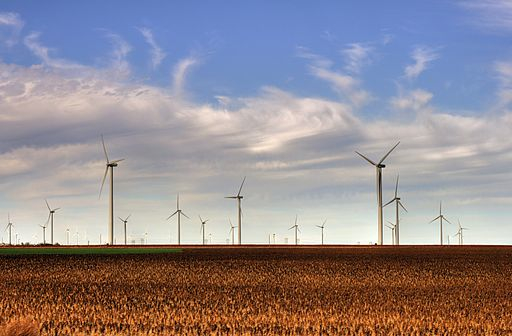
Image Credit: Wikimedia Commons
A record amount of new wind energy capacity was under construction at the end of 2013, according to the American Wind Energy Association (AWEA). The two main reasons for the wind boom are technological advancements that have lowered costs and a federal tax credit.
In an end-of-the-year summary for 2013, the industry group said in Washington on Janury 30 that wind projects with a combined capacity of more than 12,000 megawatts were under construction by the end of the year. Most of that construction, accounting for 10,900 MW, was started in the fourth quarter of the year.
One key was the Production Tax Credit, which was extended by Congress in 2013 after being allowed to lapse briefly at the start of the year. The credit, which has been in effect for more than 20 years, is worth 2.3 cents per kilowatt-hour for the first 10 years of the project.
The tax credit expired again at the end of 2013, but the industry expects it will be renewed again in 2014, according to an article from Gannett’s Washington Bureau.
Tax credit and new capacity go hand in hand
Without the tax credit, the industry slows to a crawl. According to the AWEA, when the credit is allowed to expire, wind installations drop off from 75% to 95%, as they did at the start of 2013.
Orders placed in the last part of 2013 will keep the industry busy for a while. But the AWEA says that if the tax credit isn’t back on the books by the start of the construction season in the spring, there could be trouble.
While the capacity of projects under construction hit an all-time high at the end of 2013, the total capacity that was actually installed in 2013 was quite low — 1,084 MW compared with the record-setting 13,131 MW installed during 2012. The AWEA said that the late extension of the production tax credit and an investment tax credit was to blame.
“In the absence of long-term policies, the wind industry should not be left out in the cold while Congress decides the way forward on energy,” said AWEA CEO Tom Kiernan in a prepared statement available on the organization’s website. “The [tax credit] is a highly successful policy and Congress should act quickly to extend it to maintain a stable business environment, so that wind energy can continue to provide more affordable, clean, homegrown energy.”
In all, the AWEA said in its report that there are now 61,1087 MW of installed wind capacity in the United States — enough to power 15.3 million homes.
Weekly Newsletter
Get building science and energy efficiency advice, plus special offers, in your inbox.





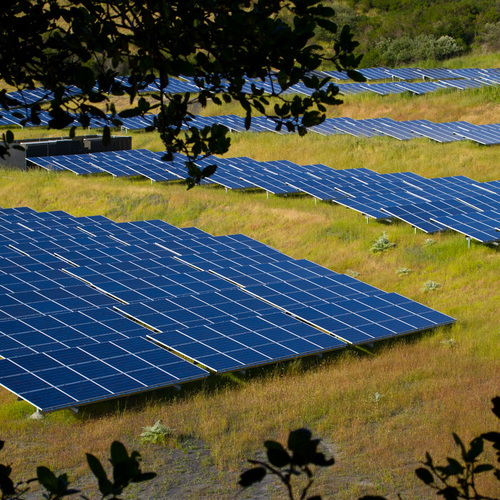
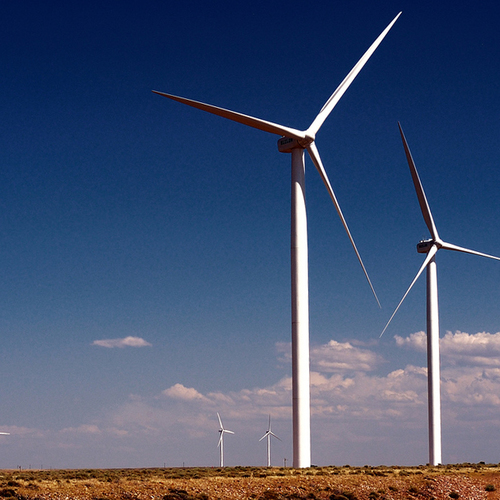
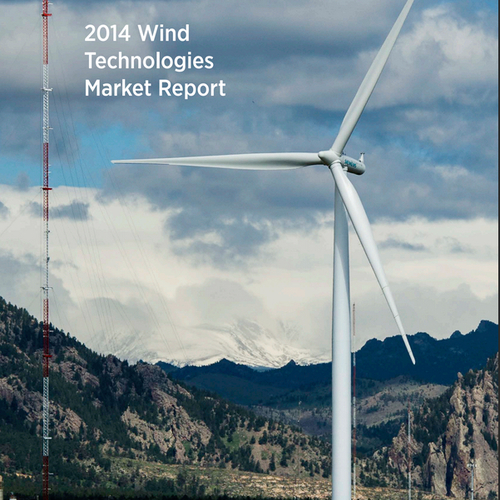
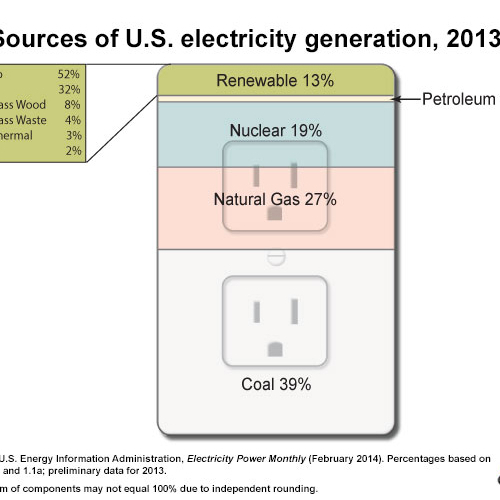






5 Comments
Wind energy reality.
I am glad that the author acknowledges that without an ongoing operating subsidy (let alone the tax breaks at time of initial construction) wind turbine installations "slow to a crawl". That's because they are simply uneconomic at this time, if one really looks behind the boosterism. The reality is that 100 units of nameplate wind energy capacity translate to less than a third of power actually delivered to end users (say < 30%). The other reality is that even this delivered power needs close to 100% "conventional" backup on standby, which boosters don't consider or include in their costing. See the site referenced below for a bit more realism.
I know that these comments will upset some greens - but that's real life, not just nice fuzzy feelings..
http://theenergycollective.com/willem-post/169521/wind-turbine-energy-capacity-less-estimated
Tony.
Very good
As long as it will result for a better future :)
In real life... (response to Anthony Ratliffe)
... everybody understand what the real capacity factors of wind are- that's not the issue. Grid operators prefer dispatchable and steady output generation to simply the management of the grid. From a lifecycle cost per Twh basis midwestern wind is cheaper than coal-fired generation, and even some combined-cycle gas. Grid operators who have (either by choice, or by imposition) taken on large amount s of wind are finding that even without grid storage there isn't much downside, and lots of up-side. But WITH rapid response grid storage it's a piece o' cake, and it doesn't take a lot of grid storage to actually get there.
The subsidy only affects the rate at which new generation gets implemented, not whether it gets implemented ever. Wind is already PLENTY cost effective as-is in many markets, but there's nothing like production tax subsidy to turn it into a no-brainer type of decision for wind developers, since they get the subsidy even when there's no demand. The vast majority of the lifecycle cost of wind is in the financing, and a big uptick in interest rates would doom some projects, in places where the existing already-built grid capacity is already sufficient for meeting the load, and where the pool of potential efficiency upgrades on both the ratepayer and grid operator's side of the meter are still deep & cheap (which is almost everywhere.) But the production credits are useful to keep the upswing sufficiently steep to make a difference from a policy point of view. With a near-zero marginal cost it's still profitable for the wind operator to run even when the spot price is slightly negative, since the financing costs are there whether they spin or not, but as long as the production credit is more than they have to pay to push power onto the grid during negative pricing periods, they're still making money. As grid storage (of even an hour) become more widely available, the amount of negative-price generation is bound to fall. If the tax credit goes away they'll either have to pull back or store power, but will never have the power-dumping problem/expense that nukes do during those low-demand periods. (It only takes a few 10s of seconds to spin up a wind farm, whereas it takes many 10s of HOURS to spin up a nuke.)
From the ratepayer's point of view having a substantial grid share of wind has proven to be a damper on rate. Since the marginal per-kwh cost of wind is very near zero, wind can always beat the spot-market on pricing, which turns out to be VERY useful during peak demand periods when low-capacity factor fossil fired peakers are setting the price. In the ERCOT grid (mostly TX) the ramp up in wind power has also pushed back on base-load power rates, and lowered the total fossil-powered baseload generators' capacity factors over the past several years DESPITE being one of the few regions of growth in the US in baseload demand over the same time period.
"Uneconomic" probably isn't the right term to be looking at it with wind- it's cheap power, but introduces some grid control issues that also carry at least some capital expense, and forces grid operators into new modes of thinking & control. Most of the hardware necessary to deal with it is known and affordable, and also worth implementing even without the introduction of wind power onto the grid to better maintain frequency/voltage/reliability. But the faster wind gets implemented, the faster some of that stuff has to be brought on, once the total grid share occupied by wind gets over some (often discussed & disputed) fraction, but 20-25% grid share (at 100% during low-demand high-wind periods) hasn't led to much need to curtail output for grid stability, even without major grid infrastructure upgrades.
Wind is only "uneconomic" in comparison to efficiency improvements on the ratepayer's side of the meter. If ratepayers all use the same long-term analysis that utilities need to do (decades instead of annual or quarterly profit/loss), the US could start shutting down all sorts of power generation without building ANY new generation capacity for decades.
Wind energy hits a (progressively) lower note.
This study http://www.friendsofscience.org/assets/documents/WindFarmsUK_Denmark_hughes2012.pdf
demonstrates that the real world performance of wind farms in Denmark and the U,K, is much worse than has been assumed, and goes on worsening over time as they age. The apparently "free energy" isn't anything of the kind, when you find yourself running at a capacity factor dropping towards 10% after ten to 15 years field life. Perhaps things are different in Texas, especially since all the wind installations there are on shore, I think, and the offshore mills in the U.K. seem to be the ones with the shortest life - anyone got equivalent figures?
Good and worthy motives to go green should not allow us to ignore factual experience.
Tony.
OK, so 15 year old offshore technology might not cut it...
... but the analysis of more recent real-world performance in TX seems to indicate that wind has been UNDER rated, from a total performance point of view, at odds with previous projections been modeled on older technology and using pre-2005 weather data for projections:
http://www.ercot.com/content/news/presentations/2013/2012%20Long%20Term%20System%20Assessment.pdf
This is the ERCOT grid operator's assessment (the guys on the hook for delivering reliable power at a reasonable cost), not wind-industry hype. It's a bit dense, but the upshot is that using better wind & weather data based on the past 15 years, adding more wind to the mix increases grid reliability and lowers the cost of power to the ratepayer.
A more "rah rah" cheerleader interpretation of this report can be found here:
http://thinkprogress.org/climate/2013/01/29/1509551/new-ercot-report-shows-texas-wind-and-solar-are-highly-competitive-with-natural-gas/
Even if positing a de-rating curve with age similar to the Danish onshore wind farms in Figure-1( http://www.friendsofscience.org/assets/documents/WindFarmsUK_Denmark_hughes2012.pdf ), where it takes a ~25% hit in capacity factor over over 15 years, at current-technology price/performance of new-tech wind it's still cheaper than new fossil-fired generation, and the extremely low marginal per-kwh cost is still low, and will continue cut the overall price of power to the both the utility & rate-payer, even as the capacity factor declines.
Underlying much of how the economics of it in the ERCOT case is the "capacity value", which is the estimate of how much is available when it's actually needed, based on measurements of it's real world performance, as opposed to mere capacity factor, or the total annual nameplate output average. The grid operator doesn't really care about the portion that's available during low demand periods, but cares very much about how much is available during high demand periods:
http://www.ercot.com/content/news/presentations/2013/CapacityDemandandReserveReport-May2013.pdf
That's also a bit dense- a very brief interpretation summary of that can be found here:
http://www.greentechmedia.com/articles/read/solar-and-wind-get-higher-capacity-values-from-ercot
Nobody (credible) has ever claimed that wind power is "free", but once built (at any capacity factor) the marginal cost of power is extremely low, and the lifecycle cost is still linked primarily to the capitalization costs, and still extremely cheap power compared to fossil-fired capacity during peak demand hours.
Log in or create an account to post a comment.
Sign up Log in